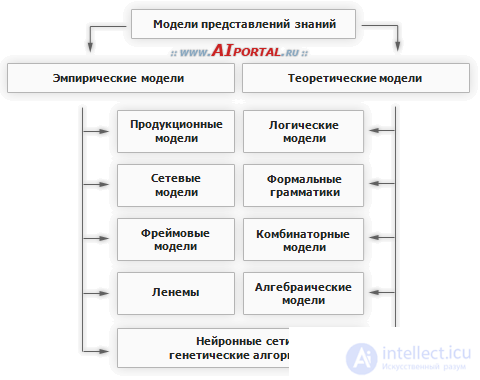Currently, many models of knowledge representation have been developed. Having a generic name, they differ in the ideas underlying them from the point of view of mathematical validity. Types of models are shown in the figure.
The first approach, called empirical , is based on the study of the principles of the organization of human memory and the modeling of mechanisms for solving problems by man. Based on this approach, the following models have been developed and are best known:
- production models - a model based on rules, allows you to present knowledge in the form of sentences like: "IF a condition, THEN action". The production model has the disadvantage that with the accumulation of a sufficiently large number (of the order of several hundred) products, they begin to contradict each other;
- network models (or semantic networks) - in knowledge engineering, it means a graph representing the meaning of a complete image. The nodes of the graph correspond to the concepts and objects, and the arcs correspond to the relations between the objects. It has the disadvantage that the unambiguous definition of the semantic network is currently missing;
- frame model - is based on such a concept as a frame (eng. frame - frame, frame). A frame is a data structure for representing a conceptual object. Information relating to the frame is contained in its constituent slots. Slots can be terminal or be frames themselves, so forming a whole hierarchical network.
These models are discussed in more detail in the corresponding articles. Conventionally, the group of empirical approach can include neural networks and genetic algorithms related to bionic (based on the assumption that if the artificial system reproduces the structures and processes of the human brain, then the results of solving problems with such a system will be similar to the results obtained by man) artificial intelligence. A feature of this type of model is the wide use of heuristics, which in each case requires proof of the correctness of the solutions obtained.
The second approach can be defined as theoretically sound , guaranteeing the correctness of the decisions. It is mainly represented by models based on formal logic (propositional calculus, predicate calculus), formal grammars, combinatorial models, in particular, models of finite projective geometries, graph theory, tensor and algebraic models. In the framework of this approach, up to now, only relatively simple tasks from a narrow subject area have been solved.

Comments
To leave a comment
Knowledge Representation Models
Terms: Knowledge Representation Models